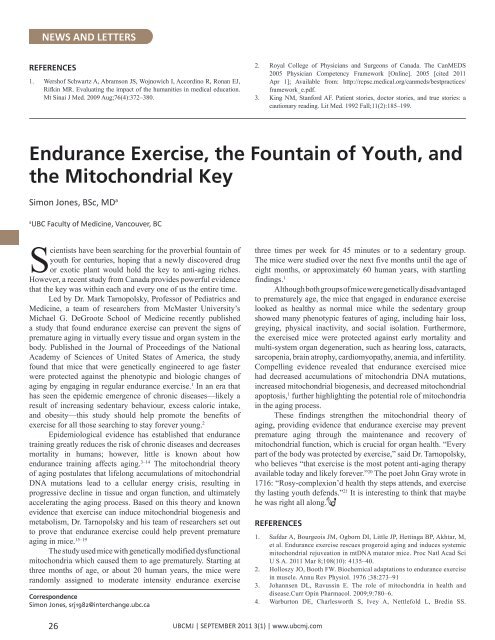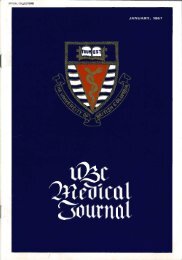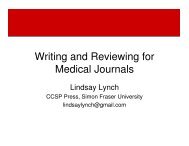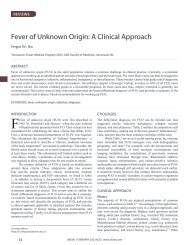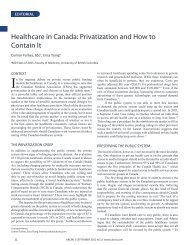Download full PDF - UBC Medical Journal
Download full PDF - UBC Medical Journal
Download full PDF - UBC Medical Journal
You also want an ePaper? Increase the reach of your titles
YUMPU automatically turns print PDFs into web optimized ePapers that Google loves.
NEWS AND LETTERS<br />
REFERENCES<br />
1. Wershof Schwartz A, Abramson JS, Wojnowich I, Accordino R, Ronan EJ,<br />
Rifkin MR. Evaluating the impact of the humanities in medical education.<br />
Mt Sinai J Med. 2009 Aug;76(4):372–380.<br />
2. Royal College of Physicians and Surgeons of Canada. The CanMEDS<br />
2005 Physician Competency Framework [Online]. 2005 [cited 2011<br />
Apr 1]; Available from: http://rcpsc.medical.org/canmeds/bestpractices/<br />
framework_e.pdf.<br />
3. King NM, Stanford AF. Patient stories, doctor stories, and true stories: a<br />
cautionary reading. Lit Med. 1992 Fall;11(2):185–199.<br />
Endurance Exercise, the Fountain of Youth, and<br />
the Mitochondrial Key<br />
Simon Jones, BSc, MD a<br />
a<br />
<strong>UBC</strong> Faculty of Medicine, Vancouver, BC<br />
Scientists have been searching for the proverbial fountain of<br />
youth for centuries, hoping that a newly discovered drug<br />
or exotic plant would hold the key to anti-aging riches.<br />
However, a recent study from Canada provides powerful evidence<br />
that the key was within each and every one of us the entire time.<br />
Led by Dr. Mark Tarnopolsky, Professor of Pediatrics and<br />
Medicine, a team of researchers from McMaster University’s<br />
Michael G. DeGroote School of Medicine recently published<br />
a study that found endurance exercise can prevent the signs of<br />
premature aging in virtually every tissue and organ system in the<br />
body. Published in the <strong>Journal</strong> of Proceedings of the National<br />
Academy of Sciences of United States of America, the study<br />
found that mice that were genetically engineered to age faster<br />
were protected against the phenotypic and biologic changes of<br />
aging by engaging in regular endurance exercise. 1 In an era that<br />
has seen the epidemic emergence of chronic diseases—likely a<br />
result of increasing sedentary behaviour, excess caloric intake,<br />
and obesity—this study should help promote the benefits of<br />
exercise for all those searching to stay forever young. 2<br />
Epidemiological evidence has established that endurance<br />
training greatly reduces the risk of chronic diseases and decreases<br />
mortality in humans; however, little is known about how<br />
endurance training affects aging. 3–14 The mitochondrial theory<br />
of aging postulates that lifelong accumulations of mitochondrial<br />
DNA mutations lead to a cellular energy crisis, resulting in<br />
progressive decline in tissue and organ function, and ultimately<br />
accelerating the aging process. Based on this theory and known<br />
evidence that exercise can induce mitochondrial biogenesis and<br />
metabolism, Dr. Tarnopolsky and his team of researchers set out<br />
to prove that endurance exercise could help prevent premature<br />
aging in mice. 15–19<br />
The study used mice with genetically modified dysfunctional<br />
mitochondria which caused them to age prematurely. Starting at<br />
three months of age, or about 20 human years, the mice were<br />
randomly assigned to moderate intensity endurance exercise<br />
Correspondence<br />
Simon Jones, srj1982@interchange.ubc.ca<br />
three times per week for 45 minutes or to a sedentary group.<br />
The mice were studied over the next five months until the age of<br />
eight months, or approximately 60 human years, with startling<br />
findings. 1<br />
Although both groups of mice were genetically disadvantaged<br />
to prematurely age, the mice that engaged in endurance exercise<br />
looked as healthy as normal mice while the sedentary group<br />
showed many phenotypic features of aging, including hair loss,<br />
greying, physical inactivity, and social isolation. Furthermore,<br />
the exercised mice were protected against early mortality and<br />
multi-system organ degeneration, such as hearing loss, cataracts,<br />
sarcopenia, brain atrophy, cardiomyopathy, anemia, and infertility.<br />
Compelling evidence revealed that endurance exercised mice<br />
had decreased accumulations of mitochondria DNA mutations,<br />
increased mitochondrial biogenesis, and decreased mitochondrial<br />
apoptosis, 1 further highlighting the potential role of mitochondria<br />
in the aging process.<br />
These findings strengthen the mitochondrial theory of<br />
aging, providing evidence that endurance exercise may prevent<br />
premature aging through the maintenance and recovery of<br />
mitochondrial function, which is crucial for organ health. “Every<br />
part of the body was protected by exercise,” said Dr. Tarnopolsky,<br />
who believes “that exercise is the most potent anti-aging therapy<br />
available today and likely forever.” 20 The poet John Gray wrote in<br />
1716: “Rosy-complexion’d health thy steps attends, and exercise<br />
thy lasting youth defends.” 21 It is interesting to think that maybe<br />
he was right all along.<br />
REFERENCES<br />
1. Safdar A, Bourgeois JM, Ogborn DI, Little JP, Hettinga BP, Akhtar, M,<br />
et al. Endurance exercise rescues progeroid aging and induces systemic<br />
mitochondrial rejuveation in mtDNA mutator mice. Proc Natl Acad Sci<br />
U S A. 2011 Mar 8;108(10): 4135–40.<br />
2. Holloszy JO, Booth FW. Biochemical adaptations to endurance exercise<br />
in muscle. Annu Rev Physiol. 1976 ;38:273–91<br />
3. Johannsen DL, Ravussin E. The role of mitochondria in health and<br />
disease.Curr Opin Pharmacol. 2009;9:780–6.<br />
4. Warburton DE, Charlesworth S, Ivey A, Nettlefold L, Bredin SS.<br />
26<br />
<strong>UBC</strong>MJ | SEPTEMBER 2011 3(1) | www.ubcmj.com


